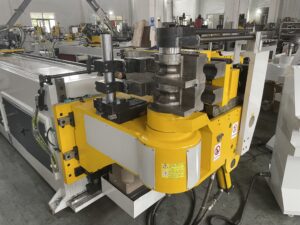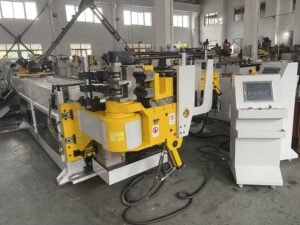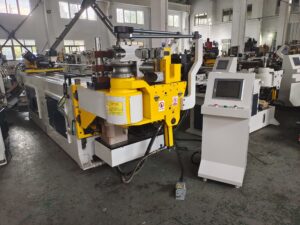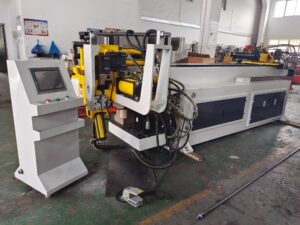What is a Muffler Pipe Bender?
When it comes to automotive repair and customization, the muffler pipe bender stands out as an essential tool for both professional mechanics and DIY enthusiasts. Whether you’re looking to replace a damaged muffler or upgrade your vehicle’s exhaust system for better sound and efficiency, understanding the role and functionality of a muffler pipe bender is crucial.

Understanding the Muffler Pipe Bender
A muffler pipe bender is a mechanical device used to precisely bend exhaust pipes and mufflers without compromising the integrity of the metal. Unlike manual bending methods, which can lead to uneven bends and potential weakening of the pipe, a pipe bender ensures consistent curvature, reducing the risk of leaks and maintaining the structural strength of the exhaust system.
Types of Muffler Pipe Benders
There are several types of muffler pipe benders, each suited to different applications and levels of precision:
- Manual Pipe Benders: These are hand-operated tools that offer flexibility and control for smaller projects.
- Hydraulic Pipe Benders: Utilizing hydraulic pressure, these benders provide greater force and precision, making them suitable for thicker pipes and more demanding tasks.
- Electric Pipe Benders: Powered by electricity, these benders offer ease of use and consistent results, bridging the gap between manual and hydraulic types.
- Computerized Pipe Benders: For the highest level of precision, computerized benders use digital controls to execute complex bends with exact measurements.
Benefits of Using a Muffler Pipe Bender
Investing in a muffler pipe bender offers numerous advantages:
- Precision: Achieve accurate bends that match the specific requirements of your vehicle, ensuring a perfect fit every time.
- Efficiency: Save time compared to manual bending methods, allowing for quicker repairs and installations.
- Durability: Maintain the structural integrity of exhaust components, reducing the likelihood of leaks and prolonging the lifespan of the exhaust system.
- Versatility: Handle a variety of pipe sizes and materials, making the tool suitable for diverse automotive applications.
- Professional Finish: Ensure a clean and professional-looking exhaust system, enhancing both performance and aesthetics.
How to Choose the Right Muffler Pipe Bender
Selecting the appropriate muffler pipe bender depends on several factors:
- Pipe Size and Material: Consider the diameter and thickness of the pipes you’ll be working with. Ensure the bender can handle the specific materials, whether it’s stainless steel, aluminized steel, or another type.
- Bending Radius: Determine the minimum and maximum bending radii required for your projects. Some benders offer adjustable settings to accommodate different curvature needs.
- Precision and Control: For intricate bends, choose a bender that offers high precision and fine control over the bending process.
- Ease of Use: Depending on your skill level, you may prefer a manual, hydraulic, or electric bender. Ensure the tool matches your comfort and expertise.
- Durability and Build Quality:
Invest in a bender made from high-quality materials to ensure longevity and reliable performance under frequent use.
- Budget: Assess your budget and balance it against the features and capabilities you need. While higher-end models offer more precision and durability, there are also cost-effective options that provide adequate functionality for basic tasks.
Applications of Muffler Pipe Benders
Muffler pipe benders are indispensable in various automotive applications:
- Exhaust System Repairs: Replace or repair damaged sections of the exhaust system, ensuring seamless integration and optimal performance.
- Custom Exhaust Builds: Create bespoke exhaust systems tailored to specific performance and aesthetic requirements, enhancing both sound and efficiency.
- Emission Control: Adjust exhaust components to comply with emission regulations, maintaining environmental standards without sacrificing performance.
- Performance Upgrades: Modify the exhaust path to improve engine performance, fuel efficiency, and overall vehicle responsiveness.
- Resale and Restoration: Restore vintage or classic vehicles by accurately reproducing original exhaust bends, preserving the vehicle’s authenticity and value.
Maintenance Tips for Muffler Pipe Benders
To ensure your muffler pipe bender remains in top condition:
- Regular Cleaning: Remove dirt, debris, and any residue from the tool after each use to prevent buildup that can impede functionality.
- Lubrication: Apply appropriate lubricants to moving parts to reduce friction and wear, ensuring smooth operation.
- Inspection: Frequently check for signs of wear, damage, or loose components. Address any issues promptly to prevent further deterioration.
- Proper Storage: Store the bender in a dry, protected environment to avoid rust and corrosion, especially if it’s a manual or hydraulic model.
Calibration: For computerized and high-precision benders, regularly calibrate the tool to maintain accuracy and consistency in your bends.
Common Mistakes to Avoid
When using a muffler pipe bender, avoid these common pitfalls:
- Incorrect Measurements:
Always double-check pipe dimensions and bend angles before starting to prevent mistakes that can lead to leaks or improper fitting.
- Overbending:
Applying too much force can weaken the pipe or cause cracks, so ensure you follow the recommended bending radius and force settings.
- Ignoring Material Specifications:
Use the appropriate bender for the pipe material to avoid damaging the exhaust components or compromising the exhaust system’s integrity.
- Poor Alignment:
Ensure the pipe is properly aligned within the bender to achieve consistent bends and avoid uneven or crooked finishes.
- Neglecting Safety Precautions:
Always wear protective gear and follow safety guidelines to prevent accidents and injuries during the bending process.
Advancements in Muffler Pipe Bending Technology
Technological advancements have significantly enhanced the capabilities of muffler pipe benders:
- Automated Systems: Integration with CNC (Computer Numerical Control) systems allows for automated, repeatable bends with minimal human intervention, increasing efficiency and precision.
- Compact Designs: Modern benders are becoming more compact and portable, making them easier to handle in limited workshop spaces or for mobile repair services.
- Enhanced Materials: The use of high-strength materials in bender construction ensures greater durability and the ability to handle more demanding tasks without wear.
- User-Friendly Interfaces: Advanced benders feature intuitive controls and digital displays, simplifying the bending process and reducing the learning curve for new users.
- Customization Features: Some benders offer programmable settings and adjustable parameters to accommodate a wider variety of bending requirements and project specifications.
Click for more detailed information.




